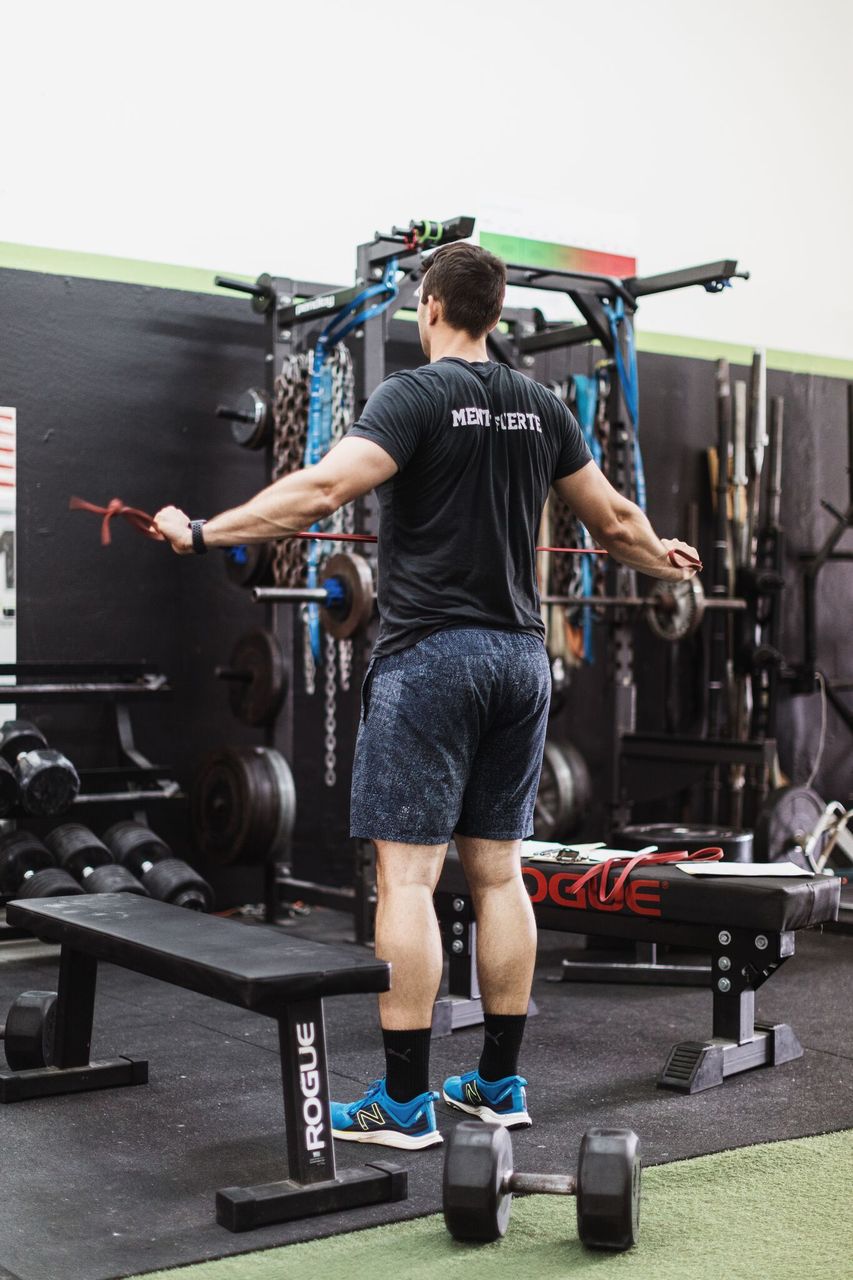The bench press is a staple to each and every training routine across the world. Over the past 2 months, the two most common questions from new athlete are 1. how much can you bench? and 2. Is that THE Tommy Edman on the wall? The answers to both are 445 and yes. Those two questions are actually what drive this blog I’m writing. No, this has nothing to do with Tommy or my ability to bench, but by working with predominantly throwing athletes my entire life, and never being one to stray away from the bench press with my throwing athletes, I have seen my share of funky things going on under a bar.
Going Against The Grain
Contrary to the what feels like the most common approach to training these days, if I see something wrong, I don’t put a band-aid on the problem, or avoid the exercises all together, I fix it. Sometimes fixing it is real fast, or it takes a little more time. But I’ll fix it, and everyone trains at full capacity. With all these years of fixing bench presses of both athletes and nonathletes there are few really common issues that I tend to fix, and fix fast!
Ultimately fixing your bench press comes down to fixing 1 thing, YOUR BENCH PRESS MECHANICS. However, your bench press mechanics are a result of a combination of things… ie. previous injuries, sport history, training history, job, stress, and even the positions you maintain while you drive. To be honest, I don’t care what causes someones issues when they show up at my gym. I mean, of course I do, but your with me to get better, your history gives me an idea, but what you show me the moment you walk in is what matters most.
Essentially, it’s the classic chicken or the egg question. Do you bench like this because of that, or, is that a certain way because of how you bench. We’re splitting hairs, and that wastes time. So let’s work with what’s in front of us, and start making some changes.

The following are the 7 most common approaches I take to cleaning up movement/loading mechanics to clean up a bench press.
Step 1. ACTUALLY learn how to bench press properly.
Benching is as much a back and lower body exercises as it is a pressing exercise, especially as loads get higher. Really focus on driving your scaps into the bench, and pushing the bar away from you. If things feel off, take a video of your bench from above and actually watch how your loading through your upper half.
Step 2. Clean up your t-spine!
Do you have enough extension and rotation to be able to load your scapula and shoulders efficiently?
As you warm up pay attention to what your scaps are doing! Can you feel both sides driving into the bench? Does your right side feel different than your left? IF that’s normal, does it feel more off than normal? If it does, take a peek in the mirror. Does that left shoulder look like its sitting a little in front of your right?
If the answer is yes, your t-spine rotation into that one side could be a little more restricted today. Or it could be a little restriction in your t-spine extension that’s changing how your driving into the bench. Quickly hop down and do some thoracic extenson and rotation exercises, here are my two favorites (add t spine exercise videos here). Remember your t-spine has ultimate say on where and how your scapula are moving. If that guy isn’t moving freely, neither are your scapula.
3. Are you doing your rows and other pulling exercises properly?
DO you do rows and struggle to find even loading through both of your lats and then turn around and struggle to press evening through both hands. DO your biceps fatigue fastest when you’re doing rows? Do your bicep tendons bother you during rows? If the answer is yet this means two things. 1. Your recruiting all the wrong muscles when you’re pulling. 2. You’re bench press isn’t turning heads.
Our brain controls which muscles are recruited during which exercise. These firing patterns are the same all across the board, whether you’re pressing or pulling. Poor movement patterns are consistent throughout your body. Your rows should be felt in your lat, post delt, abs, mid and low traps, forearms, and all that other good musculature that sits on the posterior side of your upper body. Your rows should not be felt solely in the front of your shoulder and your biceps! This fault pulling recruitment pattern is something I see on a regular basis with new athletes and clients that currently have shoulder issues, poor performance in pressing exercises, and pain when they do any sort of pressing. If this is your issue apply number 4 to your rows and bench!
4. Do More Rows and Pulling Exercises Properly!!
I know this is obvious but people still struggle with this one, based on how people structure their training programs. If you’re following the classic body building split, you’re not getting enough pulling in your life. Generally speaking, I’ll program two upper and two lower days, or three full body lifts. To me, the classic split most people follow creates a 1:1 push to pull ratio. For my guys, we’re closer to the 1:4 range push to pull. This doesn’t mean we do nothing but rows, it just means we do pressing variations twice a week. By twice I mean only barbell or dumbbell pressing once or twice a week, not flat, then incline, then decline, then flies, then pec dec, etc.

For the guy’s I work with who are power lifters, we barbell bench press, and follow it up with some close grip bench press and building in accessory lifts that specifically help where an athlete is struggling in the bench. These guys are only doing a totally of 4 pressing exercises throughout a week.
There are pulling exercises programmed into both upper and lower body days. No were not doing heavy rows every days, but on lower days, if needed, we’ll do some iso rows, banded row varieties, pull aparts of all varieties, wall slides, blackburns, t-spine ext and rot, and other weird detailed movement stuff to clean up movement and scapular control.
5. Monitor your Pressing Volume
As I mentioned just above everyone that trains in the gym follows a 4:1 pulling to pushing ratio. I don’t have a single athlete run the press variation gammet that I use to run myself though as a kid. We all know, flat bench, incline, decline, flies, and then tricep work. When I was younger, I thought it was the holy grail, I always looked forward to my Mondays. But, as I’ve gotten older, and a little wiser, I’ve come to discover that I don’t need to do 120 pressing reps in order for my chest to grow. Today, I do roughly 60 total reps pressing, and between the rows, lat pull, pull aparts, and other exercises mixed in, I’m pretty close to 240 reps.
I, like any meathead occasionally lose disciple or focus, and find myself increasing the volume of pressing exercises without increasing my pulling. Reality always kicks kicks me in the ass and I quickly started to develop more AC Joint discomfort, felt my right shoulder creeping up, and my bench press progress begins to stall.
There is clearly nothing wrong with a classic body building split, but if your shoulders hurt and you want your bench press to progress faster, maybe shift to a different training split.
6. Train Under Your Movement Threshold
Your movement threshold is the limit of where you can add load and speed before you start to compensate, falling into those bad movement patterns you’re trying to avoid. This mean, pull back on the meathead a little bit and don’t compete with the guy lying on the bench next to you (we’ve all been there). Some people will say “spend some time working on you” barf. But in all seriousness, back it off for a few weeks, feel great loading, feel even pressing, keep pushing load under your movement threshold, and “work on you”.
If you really can’t do that, I understand, because I can’t, just spend less time over that threshold. Over the years, ( I lift with a conjugate style) I’m very aware when things start getting away from me. On my max effort days, I keep reps over 85% of 1RM to 1-3. This allows me to keep my reps clean, less of a chance to piss things off that will require less time training hard, and more continued progress.
7. The “Mind Muscle Connection” You’re Using is *ucking You Up.
Some of you might have heard of the mind muscle connection. In the bodybuilding world guys train to connect the feeling of the specific muscles being trained during an exercises. For example, when you’re benching, you’re 100% focused on that feeling of your pecs firing during each rep. It’s a pretty cool feeling if you can do it, and it has to help drive muscle activation. However, if your shoulders are jacked, your number one thought when you bench shouldn’t be feeling your pecs firing… you should be finding your lats!

Here’s an example of this messing someone up…
A former body builder was recently referred to me to help with recurring shoulder pain that isn’t getting any better. Because of the pain he doesn’t touched anything over 135, but when he is benching 135, his focus is the mind muscle connection of his pecs and triceps. As a former high level body builder, you can assume he has that “mind muscle connection” dialed in.
But, he comes to me for help, so help I give. I tell him to throw out everything he thinks when he benches. Instead of focusing on his pecs and thinking about benching as a chest exercise, I tell him to create stiffness through his lats and think of it as a pulling exercise. With some quick cueing (drive your scaps into the bench, push you’re the bar away from the bench, load your scaps into your back pocket) his shoulder pain of an 8 became a 3 in less then 2 minutes. You cant make this stuff up.
Conclusion
So in conclusion, benching is awesome but it shouldn’t hurt. EVER. If it does, go through these 7 steps and you should be able to fix your problem. If not, PLEASE email me and I’ll show you some weird movement stuff that acts as a hard reset for muscular co-activation around your shoulder that is literally GOLD!!!!! Benching isn’t bad for your shoulders, bad benching is bad for your shoulders! ;-)

